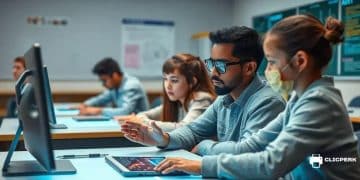Educational protections for immigrant learners: what you need to know

Educational protections for immigrant learners ensure their access to quality education through policies that provide language support, cultural competency, and community resources, helping them succeed academically and socially.
Educational protections for immigrant learners are vital in today’s diverse classrooms. Have you ever wondered how these policies shape their experiences and access to resources? Let’s explore this important topic!
Understanding educational protections
Understanding educational protections is crucial for ensuring students, especially immigrant learners, have equal access to quality education. These protections create a framework that supports diverse learners and promotes equity in the classroom. They are designed to address the challenges these students face.
What are Educational Protections?
Educational protections refer to a range of laws and policies that safeguard students’ rights in the educational system. For immigrant learners, these protections ensure they can enroll in school and receive assistance tailored to their unique needs.
Key Features of Educational Protections:
- Access to Resources: Schools must provide necessary resources, including language support and counseling services.
- Anti-Discrimination Policies: Students cannot be denied education based on their immigration status.
- Support Programs: Many schools offer programs specifically designed to help immigrant learners navigate their education.
These essential features help immigrant students thrive in their new educational environments. Many educators participate in training to better understand the needs of these students, emphasizing cultural competency and inclusive practices.
Support from the community plays a vital role. Local organizations often partner with schools to strengthen educational protections. This collaboration can lead to improved outcomes for immigrant learners, helping them integrate into the school system and promoting a welcoming atmosphere.
Why Understanding These Protections Matters
Awareness of educational protections helps everyone—educators, students, and families. When schools implement these protections, they create an environment where all students can succeed, regardless of their background. This understanding fosters community support and advocacy for necessary changes.
As we delve deeper into the subject, it becomes increasingly evident that these protections not only benefit immigrant learners but contribute to a stronger, more inclusive society overall. The ripple effect of equitable education can be profound, shaping future generations.
Key policies supporting immigrant learners
Key policies supporting immigrant learners are essential for creating an equitable education system. These policies ensure that students from diverse backgrounds receive the support they need to succeed academically. Understanding these key policies can help educators and communities provide better resources.
Important Policies to Know
Several significant policies exist to protect and support immigrant learners. These include legal protections and educational frameworks that guide schools.
- The Every Student Succeeds Act (ESSA): This act ensures all students, including immigrant learners, receive a high-quality education.
- Bilingual Education Programs: Many states have programs that provide instruction in students’ native languages, aiding their transition.
- Anti-Discrimination Laws: Regulations against discrimination ensure that schools cannot deny admission based on immigration status.
Each of these policies plays a role in creating a supportive environment for immigrant learners. They ensure that schools adapt to the needs of an increasingly diverse student population, which is vital as classrooms become more multicultural.
Additionally, many districts implement these policies through community engagement. Schools often collaborate with local organizations to enhance the educational experience. Providing resources and support systems can significantly impact the success of immigrant learners in their new educational settings.
Challenges and Opportunities
While policies are in place, challenges remain. Many immigrant learners still face barriers such as language differences and cultural adjustment. Schools must recognize these challenges and work to create inclusive environments.
Opportunities exist for improvement through increased funding and training for educators. By understanding the importance of these key policies, stakeholders can advocate for necessary changes. This can lead to better support systems that enable immigrant learners to thrive.
Challenges faced by immigrant students

Challenges faced by immigrant students can significantly impact their educational experience. These challenges often include language barriers, cultural adjustments, and feelings of isolation. Recognizing these issues is the first step in helping students thrive in their new environment.
Language Barriers
One of the most prominent challenges for immigrant students is mastering the language of instruction. Students may struggle to communicate effectively with their teachers and peers, which can hinder their academic performance. Schools need to provide robust language support programs to help these students develop their language skills.
- ESL Classes: English as a Second Language classes can guide students in learning the language.
- Tutoring Services: Extra help from tutors can boost students’ confidence and skills.
- Peer Support: Pairing immigrant students with fluent peers can facilitate learning.
As students navigate these language barriers, it’s essential to create an environment that encourages practice and interaction. Consistent use of the language in a safe space builds their confidence and fluency.
Cultural Adjustments
Alongside language difficulties, immigrant students often experience cultural adjustments. Adapting to new social norms and educational expectations can be challenging. They may feel disconnected from their new surroundings, affecting their emotional well-being.
Schools can play a crucial role in easing this transition. By incorporating cultural awareness programs, they can foster understanding among all students. Activities that celebrate diverse backgrounds promote inclusivity and help immigrant students feel more at home.
Feelings of Isolation
Many immigrant students also face feelings of isolation. Being new to a school can be daunting, especially when surrounded by longtime friends of their classmates. This feeling can lead to loneliness and affect their motivation.
Encouraging participation in extracurricular activities can help combat this isolation. Joining clubs or teams allows immigrant students to connect with peers who share similar interests. Schools should promote such opportunities actively, as they can be instrumental in building friendships and networks.
Strategies for schools to enhance support
Strategies for schools to enhance support for immigrant learners are vital in creating inclusive educational environments. By implementing effective practices, schools can help these students succeed and feel more connected to their learning community.
Implementing Bilingual Programs
Bilingual education programs are essential in supporting immigrant learners. These programs allow students to learn in both their native language and English, helping them develop strong communication skills in both languages. Critics and supporters alike agree that language proficiency is key to academic success.
- Dual Language Immersion: This model integrates both English speakers and immigrant learners in the same classroom, providing a rich cultural exchange.
- Language Support Classes: Offering extra help classes focused on English language acquisition can significantly aid students in adapting.
- Curriculum Modification: Adjusting lessons to meet the diverse needs of students helps prevent them from falling behind.
These initiatives ensure that immigrant learners receive the support necessary to thrive in their new educational settings.
Training Educators in Cultural Competency
Another important strategy is to train educators in cultural competency. Understanding different cultural backgrounds can improve teacher-student interactions. When teachers recognize and respect cultural differences, immigrant learners feel valued and understood.
Professional development that focuses on cultural responsiveness prepares educators to address the unique needs of their students. This training can include:
- Workshops: Sessions focusing on cross-cultural communication improve interactions.
- Guest Speakers: Involving community members can provide real-world perspectives that enhance learning.
- Collaboration with Families: Engaging with families helps build trust and understanding of the community’s needs.
Educational institutions can foster an inclusive atmosphere by prioritizing cultural competency.
Creating Peer Support Programs
Developing peer support programs is another effective strategy. Pairing immigrant learners with mentors or buddies can help them adjust to new routines and environments. These peers can provide assistance in navigating the school system and connecting to extracurricular activities.
Mentorship programs not only benefit the mentees but also allow mentors to develop leadership skills. Schools that promote these programs create a sense of community that supports students academically and socially.
Resources for families and educators
Resources for families and educators are essential to support immigrant learners effectively. These resources help both parents and teachers navigate the complexities of education systems and foster a positive learning environment for students.
Community Support Services
Many communities offer support services tailored to immigrant families. These services can include legal aid, counseling, and educational workshops. Utilizing these resources can empower families.
- Legal Aid Organizations: These organizations can assist families with immigration issues, ensuring their rights are respected.
- Cultural Centers: Local cultural centers provide resources and activities that promote cultural understanding and integration.
- Workshops for Parents: Educational workshops help parents understand the school system and support their children’s education.
Accessing these community resources can make a significant difference in the lives of immigrant learners and their families.
Educational Tools for Teachers
Educators need tools and strategies to effectively support immigrant learners. Professional development programs can enhance educators’ skills. These programs focus on teaching methods that cater to diverse learning styles.
Some valuable resources include:
- Teaching Materials: Culturally relevant teaching materials can make lessons more engaging for immigrant students.
- Online Training Modules: Many organizations offer online courses focused on bilingual education and cultural sensitivity.
- Collaboration Networks: Joining networks of educators can provide support and sharing of best practices.
Incorporating these resources into teaching practices can create a more inclusive classroom environment.
Technology Resources
Technology plays a crucial role in supporting immigrant learners. Various online platforms offer educational opportunities and language learning tools that can assist students in their academic journey. Access to technology can bridge the gap for students learning English.
Some popular technology resources include:
- Language Learning Apps: Apps like Duolingo and Rosetta Stone help students strengthen their language skills.
- Online Tutoring Services: Websites like Khan Academy provide supplemental educational support in various subjects.
- Virtual Communities: Online forums and social media groups where families can share experiences and tips create a sense of belonging.
By leveraging technology, families and educators can enhance the educational experience for immigrant learners.
In summary, supporting immigrant learners involves a combination of community resources, educational tools, and increased awareness of their unique challenges. Schools that implement bilingual programs, provide cultural competency training for teachers, and create peer support systems can make a significant difference in students’ lives. Families who utilize community services and technology resources will help their children succeed in their new educational settings. By working together, we can foster a supportive and inclusive environment that promotes success for all students.
FAQ – Frequently Asked Questions about Support for Immigrant Learners
What resources are available for immigrant families?
Community support services, including legal aid, educational workshops, and cultural centers, offer valuable resources for immigrant families.
How can schools support immigrant learners effectively?
Schools can implement bilingual programs, provide cultural competency training for educators, and create peer support systems to enhance support for immigrant learners.
What technology tools can help immigrant students?
Language learning apps, online tutoring services, and virtual communities are excellent technology resources that can support immigrant learners in their education.
Why is cultural competency important for educators?
Cultural competency helps educators understand and respect the diverse backgrounds of their students, promoting a more inclusive and supportive learning environment.





